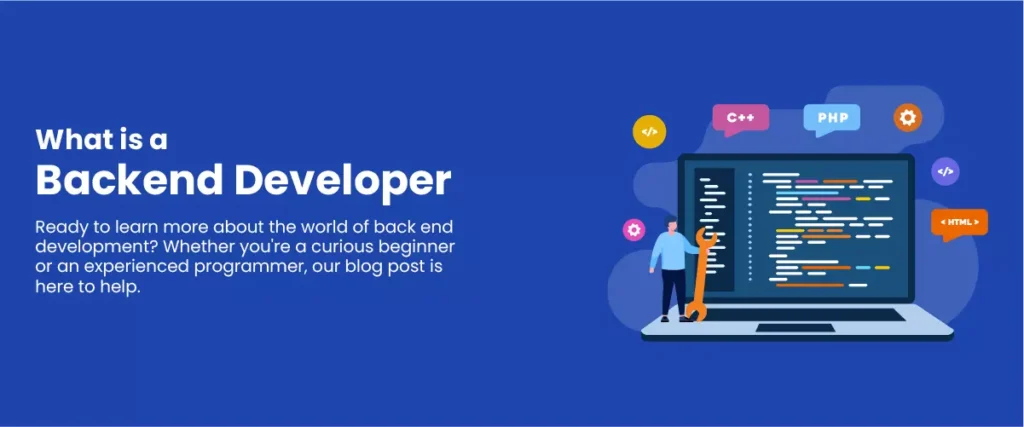In today’s digital age, where web applications and online services have become integral to our daily lives, backend development plays a crucial role in ensuring everything runs smoothly behind the scenes. While front-end developers focus on creating engaging and user-friendly interfaces, backend developers handle the core functionalities that drive these applications. In this article, we’ll explore the fundamentals of backend development, its significance, and why it’s essential for modern web applications.

What is Backend Development?
Backend development is the process of building and maintaining the server-side components of web applications. This includes servers, databases, and application logic—everything that happens behind the scenes to make a website or app functional. Essentially, backend development is concerned with how data is processed, stored, and managed, ensuring that user interactions with the front end are handled efficiently.
Key Components of Backend Development
- Server: The server is a powerful computer or system that hosts the backend application. It processes incoming requests from users, executes the necessary logic, and sends back responses. Servers can be physical machines or virtual instances in the cloud.
- Database: Databases store and manage the data that the application uses. This could be user information, content, or transaction records. Popular database systems include MySQL, PostgreSQL, MongoDB, and SQLite.
- Application Logic: This is the code that handles the functionality of the application. It includes business rules, data processing, and integration with other services. The application logic ensures that user actions are processed correctly and that data flows seamlessly between the user and the database.
- APIs (Application Programming Interfaces): APIs allow different software systems to communicate with each other. They enable the backend to interact with external services and allow the front end to request and send data.
Why Backend Development Matters
1. Performance and Speed
A well-designed backend ensures that web applications run efficiently. It optimizes data retrieval and processing, which directly impacts the speed and performance of a website or app. Fast response times are crucial for user satisfaction and retention.
2. Data Management
Backend development involves managing and securing data. By using robust database management systems and implementing proper data handling techniques, backend developers ensure that user data is stored securely and accessed efficiently.
3. Scalability
As web applications grow in popularity, they must handle increasing amounts of traffic and data. Backend developers design systems that can scale to accommodate more users and data without compromising performance. This scalability is vital for businesses that anticipate growth.
4. Security
Security is a top priority in backend development. Backend systems must protect sensitive data from unauthorized access and cyber threats. This involves implementing authentication, encryption, and other security measures to safeguard user information.
5. Integration with Other Services
Backend development often involves integrating with third-party services and APIs. This could include payment gateways, social media platforms, or external data sources. Effective integration ensures that the application can offer a wide range of features and services.
Technologies and Tools in Backend Development
- Programming Languages: Popular backend programming languages include Python, JavaScript (Node.js), Ruby, PHP, and Java. Each language has its own strengths and is chosen based on the project’s requirements.
- Frameworks: Frameworks provide a structured way to build backend applications. Some widely used frameworks are Django (Python), Express.js (Node.js), Ruby on Rails (Ruby), and Laravel (PHP).
- Databases: Depending on the needs of the application, developers might use relational databases (like MySQL or PostgreSQL) or NoSQL databases (like MongoDB or Cassandra).
- Version Control: Tools like Git help developers manage code changes and collaborate with others. Version control is essential for maintaining code quality and tracking changes.
- Cloud Services: Cloud platforms such as AWS, Google Cloud, and Azure offer scalable infrastructure and services for hosting and managing backend applications.
Conclusion
Backend development is the cornerstone of modern web applications. By handling server-side logic, data management, and integrations, backend developers ensure that web applications are functional, efficient, and secure. As technology continues to evolve, the role of backend development remains crucial in delivering seamless and reliable user experiences.
Understanding the fundamentals of backend development not only highlights its importance but also underscores the intricate work that goes into making the web applications we use every day function flawlessly. Whether you’re a budding developer or a tech enthusiast, appreciating the intricacies of backend development provides a deeper appreciation for the technology that powers our digital world.



